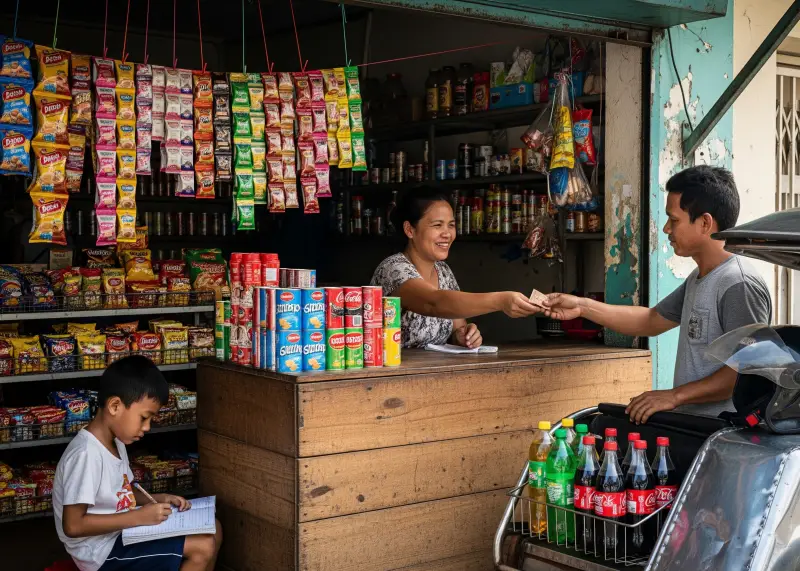In the Philippines, the pressure to finish college is strong. Parents save for years, students borrow money, and society often judges success by diplomas. But here’s the reality: not every high-paying career requires a college degree.
- 💻 1. Freelance Digital Worker
- 💄 2. Beauty & Wellness Services
- 🛠️ 3. Construction & Skilled Trades
- 🏡 4. Sales & Real Estate
- 🎧 5. Hospitality & BPO Jobs
- ⚓ 6. Seafaring & Maritime Jobs
- 🚚 7. Delivery Drivers & Logistics Jobs
- 🎨 8. Creative & Entertainment Work
- 🌾 9. Agriculture & Food Production
- 💡 10. Small Business & Entrepreneurship
- 💰 Salary Comparison: Jobs Without a Degree (Local vs. Overseas)
- ✅ Skills That Matter More Than Degrees
- ❌ Challenges of Working Without a Degree
- ❓ Frequently Asked Questions (FAQ)
- ✨ Final Reflection: Redefining Success Beyond Diplomas
- 💼 References
Many Filipinos are proving that skills, persistence, and adaptability can sometimes matter more than formal education. From freelancing to skilled trades, opportunities exist that allow you to earn a good living – without setting foot in a university classroom. Let’s explore the top 10 high-paying jobs Pinoys can get without a degree, how much they pay, and what it takes to succeed.

💻 1. Freelance Digital Worker
Freelancing and Work from Home Jobs has transformed from a side hustle into a full-time career path for thousands of Filipinos. With platforms like Upwork, Fiverr, OnlineJobs.ph, and even direct gigs through LinkedIn and Facebook groups, Pinoys are now competing in the global digital economy without needing a college diploma. What matters most is skill, consistency, and professionalism.
🌟 What Kind of Work Can You Do?
- Virtual Assistance (VA) – Managing emails, schedules, research, and admin tasks.
- Content Writing – Blog posts, SEO articles, copywriting, product descriptions.
- Social Media Management – Handling Facebook, Instagram, TikTok, and LinkedIn accounts.
- Graphic & Web Design – Logos, websites, infographics, brand kits.
- Customer Support / Chat Support – Answering customer inquiries for e-commerce stores.
- Video Editing – Short-form TikTok/Reels content, YouTube editing.
💰 Salary Range
- Beginners: ₱20,000–₱30,000/month (part-time, simple tasks like VA work).
- Mid-Level: ₱40,000–₱70,000/month (writers, social media managers, graphic designers).
- Highly Skilled Specialists: ₱80,000–₱120,000+/month (web developers, video editors, SEO experts).
Fun fact: Some Filipino freelancers servicing U.S. or Australian clients charge $8–$20/hour, which can rival or even surpass local corporate salaries.
🛠 Skills Needed
- English communication – Writing and speaking clearly.
- Digital literacy – Familiarity with MS Office, Google Workspace, Canva, Zoom.
- Specialized tools – Trello, Slack, Asana for project management; Photoshop or Premiere for creatives.
- Time management – Clients expect deadlines to be met.
- Self-discipline – No boss watching you, so you need strong work ethic.
📍 Where to Find Jobs
- Freelancing Platforms: Upwork, Fiverr, PeoplePerHour, Freelancer.com.
- Pinoy-Friendly Sites: OnlineJobs.ph, VirtualStaff.ph.
- Social Media: LinkedIn job boards, Facebook groups like “Filipino Freelancers Hub.”
- Direct Outreach: Many freelancers land clients by cold-emailing businesses abroad.
⏰ Work Expectations
- Hours: Depends on contract. Some clients want fixed shifts (8 hours/day), while others pay per project.
- Flexibility: You can often choose when and where to work, as long as you deliver.
- Workload: Can vary. A VA might handle daily admin tasks, while a designer might deliver 2–3 projects per week.
✅ Pros
- Work from home – no traffic, no gastos sa pamasahe.
- Income potential higher than many local office jobs.
- Flexible lifestyle – you can work at night, morning, or kahit saan may Wi-Fi.
- Chance to work with international clients, improving skills and exposure.
❌ Cons
- No guaranteed income at the start. You may struggle to land your first client.
- No company benefits (SSS, health insurance, etc.) unless you set them up yourself.
- Income can fluctuate depending on projects.
- Requires strong self-discipline – no boss, but deadlines are strict.
🎯 Pro Tips to Succeed
- Start small: Apply for entry-level VA or writing jobs to build a profile.
- Build a portfolio: Use free platforms like Behance (for creatives) or Medium (for writers).
- Invest in skills: Take short courses (TESDA, Coursera, YouTube tutorials).
- Be professional: Always show up on time for meetings and deliver quality work.
Freelancing proves that skills can outweigh diplomas in today’s world. For many Filipinos, it’s not just a job but a lifestyle change-working from home, earning in dollars, and having more time with family.

💄 2. Beauty & Wellness Services
Filipinos take pride in looking good and feeling good – and that’s why the beauty and wellness industry continues to thrive. The best part? You don’t need a college diploma to start. With a little training, the right tools, and good customer service, you can turn beauty skills into a steady source of income.
🌟 What Services Can You Offer?
- Haircutting & Styling – From basic trims to trendy cuts, barbers and stylists are always in demand.
- Makeup Services – For weddings, debuts, graduations, and events.
- Nail Care – Manicure, pedicure, nail art, and gel polish.
- Massage Therapy – Relaxation or therapeutic massage (popular in spas, wellness clinics, or home service).
- Skincare & Facials – Basic facials, eyebrow threading, eyelash extensions.
💰 Salary Range
- Salon employees: ₱12,000–₱18,000/month base pay, plus tips and commission.
- Freelancers (home service / by appointment): ₱300–₱1,500 per client, depending on service.
- Established professionals: ₱30,000–₱80,000/month (for stylists or makeup artists with steady clientele).
- Overseas opportunities: Skilled Filipino barbers and beauticians in the Middle East and cruise ships can earn ₱60,000–₱100,000+ monthly.
🛠 Skills Needed
- Technical skills – Cutting, coloring, makeup application, massage techniques (TESDA offers short courses in beauty care and wellness).
- Customer service – Friendliness, patience, and listening to client preferences.
- Creativity – Trends change fast, so you need to keep up with hairstyles, nail designs, or makeup looks.
- Business sense – Marketing your services on social media, managing bookings, and handling finances.
📍 Where to Find Jobs
- Local salons, spas, and barbershops – steady income and daily walk-in clients.
- Freelancing – offer home service through referrals or social media pages.
- Event-based work – connect with wedding planners, photographers, or debut organizers.
- Overseas opportunities – apply via POEA-accredited agencies for beauty and wellness jobs abroad.
⏰ Work Expectations
- Hours: Salon employees usually work 8–10 hours/day, 6 days a week.
- Freelance: More flexible, but expect weekends and holidays to be busy (especially for weddings).
- Physical demand: Be ready to stand long hours, handle chemicals, or perform massage sessions.
✅ Pros
- Always in demand – hair grows, nails grow, events never stop.
- Flexible career path – can work in salons, hotels, cruise ships, or as freelancer.
- Opportunity to grow – from small home-based services to owning a salon.
- High tipping potential – satisfied clients often give extra.
❌ Cons
- Physically tiring – long hours standing, repetitive hand movements.
- Requires investment in tools/products – scissors, makeup kits, massage oils, etc.
- Income can be unstable for freelancers without regular clients.
- Competition is strong – you need a signature style or excellent service to stand out.
🎯 Pro Tips to Succeed
- Train with TESDA or private academies (short courses often last 3–6 months).
- Create a portfolio on Instagram or Facebook to showcase your work.
- Offer promos for first-time clients to build your customer base.
- Keep learning – trends like Korean perms, gel nails, or K-beauty skincare can set you apart.
For many Pinoys, beauty and wellness work is more than just a livelihood – it’s a way of lifting confidence and bringing joy to clients. And in return, it can give you financial independence, whether you’re working in your barangay or aboard a cruise ship.

🛠️ 3. Construction & Skilled Trades
When people think of “trabaho walang diploma,” construction is often the first to come to mind. But here’s the truth: skilled trades are not just ordinary jobs – they are high-demand, high-paying careers both in the Philippines and abroad. With proper training from TESDA or apprenticeships, you can earn more than many degree holders.
🌟 What Jobs Are Included?
- Carpenters – Building homes, furniture, and custom woodwork.
- Masons & Welders – Specializing in metalwork, concrete, or structural foundations.
- Electricians – Installing and maintaining electrical systems.
- Plumbers & Pipefitters – Vital for residential, commercial, and industrial projects.
- Heavy Equipment Operators – Operating bulldozers, cranes, and excavators.
- Foremen & Site Supervisors – Experienced workers leading construction teams.
💰 Salary Range
- Local (Philippines): ₱12,000–₱20,000/month for entry-level; skilled workers (electricians, welders) can reach ₱25,000–₱35,000/month.
- Overseas (Middle East, Japan, Canada, Europe): ₱60,000–₱120,000/month, with free housing and other benefits. Welders and electricians are especially sought-after.
- Freelance / Project-Based: Skilled workers (like masons or carpenters) can earn ₱800–₱2,000 per day depending on expertise.
🛠 Skills Needed
- Technical knowledge – From construction basics to safety protocols (TESDA certifications are a big plus).
- Physical strength & stamina – Work is physically demanding, often outdoors.
- Problem-solving – Fixing wiring issues, structural misalignments, or plumbing leaks.
- Teamwork – Construction requires collaboration with engineers, architects, and other workers.
- Attention to detail – A small mistake in wiring or structure can cause major problems.
📍 Where to Find Jobs
- Local construction companies – Building homes, condos, malls, and government projects.
- Abroad via POEA-accredited agencies – Demand is strong in the Middle East, Japan, and Canada.
- Freelance – Many Pinoys offer carpentry, electrical, and repair services directly within their barangays.
- Government infrastructure projects – Roads, bridges, schools (via contractors).
⏰ Work Expectations
- Hours: Typically 8–10 hours per day, 6 days a week.
- Environment: Outdoor sites, often under the sun or in noisy environments.
- Overseas: More structured, with strict safety protocols but longer contracts (1–2 years).
✅ Pros
- High demand locally and abroad.
- Does not require a college degree – skills and experience matter most.
- Opportunity to migrate or work overseas with much higher pay.
- Clear path to entrepreneurship – many start as workers, later open their own construction businesses.
❌ Cons
- Physically exhausting and sometimes dangerous work.
- Risk of injury if safety standards aren’t followed.
- Unstable income for freelancers when projects slow down.
- Often seen as “blue-collar,” which carries unfair stigma despite high earnings.
🎯 Pro Tips to Succeed
- Get TESDA certification in your trade – this makes you more attractive to employers, especially abroad.
- Invest in quality tools; reliable equipment can set you apart from average workers.
- Build a reputation locally – referrals are powerful in construction.
- Consider working abroad for a few years to build savings, then start your own small construction company at home.
Skilled trades prove that “walang diploma, walang kita” is a myth. In fact, many electricians, welders, and carpenters earn more than office workers. These are the hands that build our homes, roads, and cities – and they deserve the respect and pay that comes with it.

🏡 4. Sales & Real Estate
In the Philippines, sales is often called the “great equalizer.” It doesn’t matter if you graduated from UP or didn’t finish college – if you can sell, you can earn big. Real estate, insurance, and direct sales are especially profitable, giving ambitious Pinoys the chance to build wealth purely from skill and determination.
🌟 What Jobs Are Included?
- Real Estate Agent / Broker – Selling condos, houses, and lots.
- Insurance Agent – Helping families secure financial protection while earning commissions.
- Direct Selling – Avon, Tupperware, personal care products, health supplements.
- Corporate Sales – Selling products or services to companies (B2B sales).
- Car Sales Agent – Dealership sales for vehicles, one of the fastest-growing markets.
💰 Salary Range
- Real Estate Agents: Commission-based; ₱20,000–₱50,000/month average, but top earners hit ₱100,000+ especially when selling condos in Metro Manila.
- Insurance Agents: ₱15,000–₱30,000/month starting, with potential ₱80,000–₱120,000+ for consistent performers.
- Direct Selling: Highly variable – part-timers might earn ₱5,000/month, but network leaders earn ₱50,000+.
- Car Sales Agents: ₱12,000–₱20,000 base pay, plus ₱5,000–₱30,000 in commissions depending on sales volume.
🛠 Skills Needed
- Communication – Clear, persuasive speaking and writing.
- Negotiation – Knowing how to close deals while making clients feel valued.
- Networking – Building strong relationships for referrals.
- Self-motivation – Commission work is tough; success depends on effort.
- Product Knowledge – You need to master what you’re selling, whether it’s a condo unit or an insurance plan.
📍 Where to Find Jobs
- Real Estate Developers – Ayala Land, SMDC, Megaworld, Camella, etc.
- Insurance Companies – Sun Life, AXA, Manulife, PruLife.
- Car Dealerships – Toyota, Honda, Ford, Mitsubishi.
- Direct Selling Companies – Avon, Tupperware, Frontrow, Atomy, etc.
- Freelance & Networking – Facebook pages, referrals from friends/family.
⏰ Work Expectations
- Hours: Flexible, but expect long days during peak sales months or when clients are available (nights, weekends).
- Environment: Client meetings, open houses, networking events, showroom demos.
- Pressure: High. You only earn when you sell, so consistency is key.
✅ Pros
- Unlimited income potential – the more you sell, the more you earn.
- Flexible schedule – especially in real estate and insurance.
- No degree requirement – success relies on skill and charisma.
- Opportunities for career growth – top performers often become managers or team leaders.
❌ Cons
- Commission-based – income can be unstable, especially at the start.
- High rejection rate – you need thick skin to handle “no’s.”
- Requires constant networking and client follow-ups.
- Competitive market – especially in Metro Manila real estate.
🎯 Pro Tips to Succeed
- Start with a company that offers good training programs (many real estate and insurance companies do this for free).
- Use social media to promote your services – Facebook Marketplace, TikTok, and Instagram are powerful tools.
- Focus on trust, not just sales – clients will refer you if they feel valued and respected.
- Treat every client meeting as an opportunity to build long-term relationships.
Sales and real estate prove that confidence and persistence can sometimes be worth more than a diploma. In a country where millions dream of owning a home or securing their future, skilled Filipino salespeople are the bridge between dreams and reality.

🎧 5. Hospitality & BPO Jobs
When it comes to job opportunities that don’t demand a diploma, hospitality and the BPO (Business Process Outsourcing) industry are game changers. These sectors thrive on skills, attitude, and adaptability – not your college transcript. For many Pinoys, call centers, hotels, and cruise ships have become a ticket to financial stability, career growth, and even global opportunities.
🌟 What Jobs Are Included?
BPO Industry (Call Centers & IT Services)
- Customer service representatives (CSR)
- Technical support specialists
- Chat/email support
- Sales representatives
- Content moderators
Hospitality & Tourism
- Hotel front desk clerks
- Food and beverage service crew
- Housekeeping staff
- Bartenders & baristas
- Cruise ship service staff
💰 Salary Range
- BPO (Philippines): ₱18,000–₱25,000/month starting for CSRs; ₱30,000–₱60,000+ for experienced agents, especially in tech accounts.
- Team leaders & trainers: ₱40,000–₱80,000/month depending on company.
- Hospitality (Local Hotels/Restaurants): ₱12,000–₱20,000/month starting; ₱25,000–₱40,000/month for senior staff in luxury hotels.
- Cruise ships/Overseas Hospitality: ₱60,000–₱120,000+/month, with free food and lodging.
🛠 Skills Needed
- English proficiency – Essential for BPO and international hospitality roles.
- Customer service mindset – Patience, empathy, and professionalism.
- Adaptability – Shifts can rotate (night shift for BPO, holidays/weekends for hotels).
- Computer literacy – Basic typing and navigation for BPO roles.
- Presentation skills – Grooming, hospitality etiquette, and communication for hotels/cruise work.
📍 Where to Find Jobs
- BPO Companies: Concentrix, Teleperformance, Accenture, Alorica, Sitel.
- Hotels & Resorts: Shangri-La, Okada, SEDA, Dusit Thani, local boutique hotels.
- Cruise Lines: Royal Caribbean, Carnival, Norwegian Cruise Line (via POEA-accredited agencies).
- Job Sites: JobStreet, Kalibrr, Mynimo, and Facebook job groups.
⏰ Work Expectations
- BPO: Night shifts (U.S. hours), repetitive but structured environment, weekly metrics (customer satisfaction, call handling time).
- Hospitality: Long hours, often on weekends and holidays, but opportunities to meet people and grow customer service expertise.
- Cruise Ships: 6–10 month contracts abroad, working 10–12 hours a day, but with excellent pay and travel perks.
✅ Pros
- Stable employment with benefits (HMO, allowances, government benefits).
- Clear career path – many rise from CSR to trainer, supervisor, or manager in just a few years.
- Strong overseas opportunities in hospitality.
- Training is often provided by the company – no degree required.
❌ Cons
- Demanding schedules – night shifts in BPO, holidays for hospitality.
- High stress levels – irate customers, strict KPIs, or physically tiring hospitality work.
- Attrition rates are high – burnout is common.
- For cruise work: long separations from family.
🎯 Pro Tips to Succeed
- Improve your English and communication skills – practice daily, watch English shows, or take online courses.
- Prioritize health – night shifts and long hours can be tough on the body, so rest and nutrition matter.
- Build professional grooming and etiquette – especially for hotel/cruise ship work.
- Stay long enough to gain experience – promotions are often fast for dedicated workers.
The BPO and hospitality industries have uplifted millions of Filipino families. They prove that with communication skills, perseverance, and service-oriented values, you can secure a stable career and even explore the world – no diploma required.

⚓ 6. Seafaring & Maritime Jobs
The Philippines is known as the “Seafaring Capital of the World,” with nearly 400,000 Filipinos working on ships at any given time. For many kababayans, stepping onto a ship has been the gateway to financial stability, home building, and sending kids to school – all without requiring a college degree. Instead, what matters here is training, discipline, and the willingness to work far from home.
🌟 What Jobs Are Included?
- Deck Ratings – Ordinary Seaman (OS), Able-Bodied Seaman (AB), Bosun.
- Engine Ratings – Wiper, Oiler, Motorman.
- Catering Crew – Messman, Cooks, Utility.
- Specialized Roles – Welders, Fitters, Pumpmen.
Many of these positions require TESDA-accredited courses and training from maritime schools but not a 4-year college degree.
💰 Salary Range
- Entry-Level (OS, Wiper, Messman): ₱25,000–₱50,000/month.
- Skilled Ratings (AB, Oiler, Cook, Motorman): ₱60,000–₱100,000/month.
- Specialized Crew (Welder, Fitter, Pumpman): ₱80,000–₱120,000+/month.
- Officers (after years of experience + licenses): ₱150,000–₱350,000/month.
Aside from salaries, many contracts include free food, lodging, insurance, and medical care.
🛠 Skills & Training Needed
- Basic Seaman Training (BST) – Required for all seafarers, covering safety, firefighting, and first aid.
- Specialized Courses – Welding, cooking, machinery operations, etc.
- Discipline & Teamwork – Ship life is tough; following orders and working as a team is critical.
- Physical & Mental Strength – Long hours, harsh weather, and homesickness are part of the job.
📍 Where to Find Jobs
- Manning Agencies (POEA-accredited) – examples: Magsaysay Maritime, OSM, CF Sharp.
- Local Maritime Schools & TESDA – many partner with agencies for direct hiring.
- Job Portals – SeamanJobsite.com, JobStreet (Maritime section).
⏰ Work Expectations
- Contracts: 6–10 months onboard, 2–3 months vacation in between.
- Hours: 8–12 hours a day, 7 days a week. Emergencies may require extra shifts.
- Environment: Confined space, strict rules, international crew.
✅ Pros
- Very high earning potential without a degree.
- Free lodging, meals, and travel – minimal living expenses while onboard.
- Opportunities to travel the world.
- Clear path to promotion with experience and further certifications.
❌ Cons
- Long separation from family, leading to emotional strain.
- Physically demanding and dangerous – storms, machinery accidents, piracy threats.
- Strict discipline and hierarchy.
- Homesickness is a constant battle.
🎯 Pro Tips to Succeed
- Start early by enrolling in TESDA or maritime short courses.
- Choose only POEA-accredited agencies to avoid scams.
- Prioritize health and fitness – many contracts require strict medical clearances.
- Save and invest your earnings wisely – seafaring pays well but is not forever.
For many Filipino families, isang seaman lang ang kayang magpaaral sa apat na magkakapatid. Seafaring remains one of the most challenging yet rewarding careers for Pinoys without a degree – proof that hard work on the seas can change lives on land.

🚚 7. Delivery Drivers & Logistics Jobs
From jeepneys and delivery riders to truckers hauling goods across provinces, drivers and logistics workers are the backbone of the Philippine economy. Post-pandemic, e-commerce and transport needs have skyrocketed, making these jobs both accessible and essential. For many Filipinos without a diploma, driving and logistics offer steady income and even overseas opportunities.
🌟 What Jobs Are Included?
- Local Drivers – Jeepney, tricycle, taxi, UV express, ride-hailing (Grab, JoyRide, Angkas).
- Delivery Riders – Food delivery (GrabFood, Foodpanda), parcel delivery (Lalamove, TokTok, Shopee Express).
- Truck & Bus Drivers – Long-haul trucking, provincial bus driving.
- Logistics Crew – Warehouse staff, forklift operators, dispatchers.
- International Opportunities – Truck drivers in Canada, New Zealand, and Middle East; bus drivers in Singapore and Hong Kong.
💰 Salary Range
- Delivery Riders: ₱10,000–₱25,000/month, depending on hours and demand.
- Local Drivers (Taxi/UV/Jeepney/Grab): ₱15,000–₱35,000/month average, with potential ₱50,000+ for full-time Grab drivers.
- Truck Drivers (Local): ₱20,000–₱40,000/month.
- Bus Drivers (Provincial Routes): ₱20,000–₱35,000/month, plus incentives.
- Overseas Drivers: ₱80,000–₱150,000/month, often with free housing.
- Warehouse Crew: ₱12,000–₱20,000/month locally; ₱40,000–₱80,000/month abroad.
🛠 Skills Needed
- Driver’s License – Professional driver’s license required for trucks, buses, and ride-hailing.
- Navigation Skills – Using Waze, Google Maps, or local knowledge of routes.
- Basic Vehicle Maintenance – Checking oil, tires, and handling minor repairs.
- Time Management – Meeting delivery deadlines.
- Physical Strength – For logistics crew handling packages.
📍 Where to Find Jobs
- Ride-Hailing Platforms – Grab, Angkas, JoyRide.
- Delivery Services – Lalamove, Shopee Xpress, J&T Express, TokTok.
- Logistics Companies – 2GO, DHL, Lazada logistics hubs.
- Provincial Bus & Trucking Firms – Victory Liner, Ceres Bus, local cargo firms.
- Overseas – POEA-accredited agencies recruiting truck and bus drivers.
⏰ Work Expectations
- Hours: 8–12 hours/day depending on role; delivery riders often work flexible shifts.
- Environment: On the road most of the day, exposed to traffic, heat, and weather.
- Overseas: Longer shifts but higher pay; strict traffic rules and safety checks.
✅ Pros
- Always in demand – people and goods always need to move.
- Accessible career path – requires skills, not a diploma.
- Flexible for riders – you choose when to log in and deliver.
- High overseas demand – truck drivers are among the most recruited Pinoys abroad.
❌ Cons
- Risk of road accidents, especially in heavy traffic or long drives.
- Earnings for riders can fluctuate depending on demand and fuel prices.
- Physically exhausting – long hours driving or lifting packages.
- Overseas jobs may require long contracts away from family.
🎯 Pro Tips to Succeed
- Upgrade your license (from non-pro to pro) to open more opportunities.
- Keep a clean driving record – agencies abroad are strict about violations.
- Maintain your vehicle or motorbike well to avoid costly downtime.
- For riders, maximize peak hours and promo incentives to boost earnings.
- Consider logistics certifications (like forklift training via TESDA) for added opportunities.
For many Filipinos, being a driver or delivery rider is more than just a job – it’s a lifeline for their families. It may be tiring, but it’s also rewarding, proving that dedication and hard work on the road can put food on the table and even build long-term stability.

🎨 8. Creative & Entertainment Work
In the age of social media and digital platforms, Filipinos with creative skills are finding ways to turn passion into paychecks. Whether it’s through music, art, or online content, the creative and entertainment industry has given thousands of Pinoys a way to earn without needing a degree – just talent, consistency, and a little marketing savvy.
🌟 What Jobs Are Included?
- Content Creators – YouTubers, TikTokers, streamers (Facebook Gaming, Twitch).
- Musicians & Performers – Singers, band members, wedding performers, street buskers.
- Writers & Artists – Comic book artists, graphic designers, illustrators.
- Video Editors & Filmmakers – For weddings, events, ads, or YouTube collaborations.
- Photographers – Wedding, portrait, product photography.
- Actors / Models – TV, indie films, commercials, and online ads.
💰 Salary Range
- Content Creators: ₱5,000–₱50,000+/month depending on views, sponsorships, and brand deals. Top Pinoy YouTubers earn millions.
- Musicians (Gigs/Weddings): ₱3,000–₱10,000 per event; bands earn ₱10,000–₱30,000.
- Photographers/Videographers: ₱15,000–₱50,000 per project, higher for weddings.
- Graphic Designers/Artists: ₱20,000–₱40,000/month freelancing; higher if abroad or on Upwork/Fiverr.
- Actors/Models: ₱5,000–₱50,000 per project depending on role and exposure.
🛠 Skills Needed
- Creativity & Talent – Artistic or performance ability is the foundation.
- Technical Knowledge – Editing software (Adobe Premiere, Photoshop), instruments, or camera equipment.
- Consistency – Especially for content creators; posting regularly builds an audience.
- Marketing Skills – Promoting yourself on social media, networking with clients.
- Resilience – Handling criticism, rejections, and unstable income.
📍 Where to Find Jobs
- Freelance Platforms – Upwork, Fiverr, OnlineJobs.ph (for creative gigs).
- Social Media – YouTube, TikTok, Instagram for direct monetization.
- Event Companies – Wedding planners, production houses, ad agencies.
- Talent Agencies – For acting, modeling, or endorsements.
- Local Gigs – Bars, restaurants, or online events for musicians.
⏰ Work Expectations
- Content Creators: No fixed hours, but requires long hours filming, editing, and engaging with followers.
- Artists & Designers: Project-based, with deadlines and revisions.
- Musicians & Performers: Gigs are often evenings or weekends.
- Actors/Models: Long shoots, sometimes 10–14 hours a day.
✅ Pros
- Can turn hobbies into careers.
- Freedom and flexibility – be your own boss.
- Potential for very high earnings if you “make it.”
- Opportunity to inspire and entertain others.
❌ Cons
- Highly competitive – many try, few succeed big.
- Income instability – “gig economy” means some months are busy, others dry.
- Requires self-promotion and resilience to rejection.
- Success often takes time and consistency.
🎯 Pro Tips to Succeed
- Find your niche – don’t just copy trends, add your unique Filipino flavor.
- Invest in basic gear (a good phone camera + mic can go a long way).
- Build a portfolio (Instagram for photos, YouTube for videos, Behance for art).
- Collaborate – growth often comes through community, not isolation.
- Treat it like a business – budget, reinvest in better equipment, and keep records.
Creativity has always been part of Filipino identity – from street singers in jeepneys to digital creators making viral content. With the right mix of passion and persistence, the arts can go from “sideline” to pangunahing hanapbuhay.

🌾 9. Agriculture & Food Production
For generations, agriculture has been the backbone of the Philippine economy. While it’s often seen as “traditional work,” modern farming and food production now offer opportunities that can rival office jobs – especially with the rising demand for organic produce, local delicacies, and sustainable farming practices. You don’t need a diploma to start, but you do need patience, resourcefulness, and a willingness to get your hands dirty.
🌟 What Jobs Are Included?
- Farm Workers / Farmers – Planting and harvesting rice, corn, vegetables, or fruits.
- Poultry & Livestock Workers – Managing chickens, hogs, cattle, or goats.
- Fishery & Aquaculture – Tilapia, bangus, shrimp farming.
- Urban Farming – Hydroponics, vertical gardens, mushroom farming.
- Food Production / Processing – Small-scale kakanin, dried fish, or bottled goods.
💰 Salary Range
- Farm Workers (Local): ₱300–₱600/day, ₱9,000–₱15,000/month.
- Farm Owners / Entrepreneurs: Profits can reach ₱30,000–₱100,000+ per harvest depending on crop and scale.
- Poultry & Livestock: ₱20,000–₱60,000/month profit potential for small operators; much higher for large-scale.
- Aquaculture: ₱50,000–₱150,000 per harvest cycle.
- Processed Food (Sideline Business): ₱5,000–₱30,000/month depending on market reach.
🛠 Skills Needed
- Basic Farming Knowledge – Planting, harvesting, feeding, or caring for animals.
- Patience & Discipline – Farming is seasonal; income isn’t always instant.
- Business Sense – Selling produce at palengke, local suppliers, or via social media.
- Adaptability – Using modern techniques (organic farming, hydroponics) for higher yield.
- Manual Skills – Repairing tools, irrigation, and handling basic equipment.
📍 Where to Find Jobs & Opportunities
- Local Farms – Rice fields, poultry farms, piggery, vegetable farms.
- Agricultural Cooperatives – Many towns have co-ops for farmers and fisherfolk.
- TESDA Training – Free courses in animal raising, crop production, and food processing.
- Government Programs – DA, DTI, and LGUs offer grants and loans for agri-preneurs.
- Own Backyard / Land – Even a small plot or rooftop can start an agri-business.
⏰ Work Expectations
- Hours: Early mornings and long days, especially during planting or harvest seasons.
- Environment: Outdoor, exposed to weather conditions.
- Seasonal Work: Income may come in cycles; requires planning and saving.
✅ Pros
- High demand – Filipinos will always need food.
- Can start small and scale up.
- Government support and TESDA training available.
- Opportunity to turn into a family business.
❌ Cons
- Physically demanding work.
- Vulnerable to typhoons, pests, and price fluctuations.
- Seasonal income – requires financial planning.
- Seen as “low prestige” by some, despite high potential.
🎯 Pro Tips to Succeed
- Start with high-demand crops (gulay, poultry eggs, tilapia).
- Join a cooperative for shared resources and better market prices.
- Explore agri-tech methods (hydroponics, greenhouse farming) to increase yield.
- Diversify – don’t depend on just one crop or livestock.
- Document and promote your produce online – social media is a growing agri-marketplace.
Agriculture reminds us that “ang lupa, hindi napapagod.” For Filipinos without a degree, farming and food production may not look glamorous, but it can provide a steady livelihood – and even grow into a thriving agribusiness with the right mindset.

💡 10. Small Business & Entrepreneurship
For Filipinos without a degree, starting a negosyo is one of the most empowering ways to earn. It doesn’t matter if it’s a small sari-sari store, an online sideline, or a growing food stall – entrepreneurship gives you control over your time, income, and future. Many of today’s successful Filipino entrepreneurs started with little capital and no diploma, relying on diskarte, tiyaga, at sipag.
🌟 What Businesses Are Included?
- Food Stalls & Carinderias – Lugawan, tapsilogan, or merienda carts.
- Sari-Sari Stores – Still a classic for community-based income.
- Online Selling – Shopee, Lazada, Facebook Marketplace, TikTok shop.
- Franchises – Food carts, laundry kiosks, water refilling stations.
- Service-Based Negosyo – Printing, barber shops, laundry, repair services.
- Creative Ventures – Ukay-ukay shops, handmade crafts, online thrift stores.
💰 Income Potential
- Food Stalls/Carinderia: ₱1,500–₱5,000 daily sales, depending on location.
- Sari-Sari Store: ₱500–₱2,000 daily, steady but smaller profit margins.
- Online Selling: ₱10,000–₱50,000+/month, higher during peak seasons.
- Franchises: Potential ROI in 12–24 months depending on traffic.
- Service Negosyo: ₱15,000–₱40,000/month average; can grow bigger with loyal customers.
🛠 Skills Needed
- Entrepreneurial Mindset – Willingness to take risks and solve problems.
- Customer Service – Keeping suki happy is the secret to repeat sales.
- Basic Accounting – Tracking expenses, profits, and reinvestments.
- Marketing Skills – Social media, word of mouth, and promos.
- Resilience – Accepting that not every business works out, but lessons build future success.
📍 Where to Start
- Online Platforms – Facebook groups, Shopee, TikTok.
- Local Markets – Start small with a stall in your barangay or palengke.
- Franchise Networks – Explore affordable franchises under ₱500k.
- Government Programs – DTI Negosyo Centers, livelihood loans from SSS or Pag-IBIG.
⏰ Work Expectations
- Long hours at the start – entrepreneurs often juggle everything (selling, marketing, inventory).
- Income may fluctuate depending on season and demand.
- Growth takes time – patience and reinvestment are key.
✅ Pros
- Full control – be your own boss.
- Unlimited earning potential.
- Builds long-term wealth and legacy.
- Flexible – you choose the business that fits your lifestyle.
❌ Cons
- High risk – many small businesses close in the first 1–2 years.
- No fixed income – income depends on effort and demand.
- Requires multi-tasking – you wear many hats at once.
🎯 Pro Tips to Succeed
- Start small but scalable – test the market before going big.
- Focus on customer loyalty – happy customers are free marketing.
- Track every peso – discipline in finances separates failing and thriving businesses.
- Keep learning – attend seminars, watch tutorials, or join entrepreneur groups.
- Diversify income – never rely on one product or one customer base.
For many Filipinos, small businesses have turned into family empires. The sari-sari store evolves into a mini-grocery, the food cart becomes a restaurant, the online seller grows into a brand. Entrepreneurship proves that with vision and determination, your future isn’t written on a diploma – it’s written in your diskarte.
💰 Salary Comparison: Jobs Without a Degree (Local vs. Overseas)
Before you decide which career path to take, it helps to compare the earning potential of each option. Some jobs may start with modest pay locally but open doors to lucrative overseas opportunities. Others, like freelancing or small businesses, can grow quickly if you invest in your skills and consistency. This table gives you a side-by-side look at how much you can realistically earn – both in the Philippines and abroad – without needing a college degree.
| Career Path | Local Salary Range | Overseas Potential |
|---|---|---|
| 🎨 Freelance Digital Work | ₱20,000 – ₱100,000+/month (depending on clients/projects) | $1,500 – $4,000/month (remote clients, global freelancing) |
| 🔧 Skilled Trades (Welders, Electricians, Mechanics) | ₱15,000 – ₱40,000/month | ₱80,000 – ₱150,000/month (Middle East, Europe, Asia) |
| 💇 Service Jobs (Beauty, Wellness, Repair) | ₱12,000 – ₱25,000/month | ₱60,000 – ₱120,000/month (salons, spas, caregiving abroad) |
| 📞 BPO & Hospitality | ₱18,000 – ₱40,000/month (CSR, hotel staff) | ₱60,000 – ₱120,000+/month (cruise ships, international hotels) |
| ⚓ Seafaring & Maritime | ₱25,000 – ₱100,000/month (ratings/crew) | ₱150,000 – ₱350,000/month (officers, senior crew) |
| 🚚 Drivers & Logistics | ₱15,000 – ₱40,000/month (truck/bus/riders) | ₱80,000 – ₱150,000/month (truck drivers abroad) |
| 🎭 Creative & Entertainment | ₱10,000 – ₱50,000+/month (gigs, content creation) | $1,000 – $5,000+/month (international gigs, YouTube income, film) |
| 🌾 Agriculture & Food Production | ₱9,000 – ₱30,000/month (farm work, small agri-business) | ₱40,000 – ₱120,000+/month (farmers, food production abroad) |
| 💡 Small Business & Entrepreneurship | Highly variable (₱10,000 – ₱100,000+ depending on scale) | N/A – but scalable to global through e-commerce exports |
| 🛠 Skilled Crafts & Food Production (Kakanin, Carinderia, Ukay) | ₱10,000 – ₱50,000/month | ₱60,000 – ₱100,000+/month (food stalls, retail abroad) |
✅ Skills That Matter More Than Degrees
- ✅ Strong English and communication skills.
- ✅ Digital literacy and adaptability.
- ✅ Customer service and people skills.
- ✅ Creativity and problem-solving.
- ✅ Persistence and networking ability.
❌ Challenges of Working Without a Degree
- ❌ Limited access to some formal corporate roles.
- ❌ Need to constantly prove your skills.
- ❌ Risk of unstable income (especially freelancers).
- ❌ Lack of benefits compared to traditional jobs.
- ❌ Social stigma in some circles.
❓ Frequently Asked Questions (FAQ)
Q1: Can you really earn a high income without a degree in the Philippines?
Yes. Many Filipinos are earning well above average without finishing college, especially in trades, freelancing, and sales. What matters most is building specialized skills and work experience.
Q2: Which job pays the most among those without a degree?
Sales representatives and freelancers often have the highest income potential locally, while OFW jobs in construction, logistics, or food service can pay six-figure salaries abroad.
Q3: Do you need certifications for these jobs?
Not always, but certifications help. For example, IT support specialists benefit from Cisco or CompTIA certificates, while hairstylists or welders may need TESDA training.
Q4: Are freelancing jobs stable?
Freelancing can be unstable at first, but those who build portfolios and loyal client bases often achieve stable, high-paying work. Success depends on adaptability and consistent skill upgrades.
Q5: Do small businesses really succeed without degrees?
Yes, many successful Filipino entrepreneurs never completed college. Business success depends more on strategy, grit, and understanding customer needs.
Q6: What about social stigma of not finishing college?
It still exists, but attitudes are shifting. As more Filipinos succeed through skills and entrepreneurship, the emphasis on diplomas is slowly being challenged.
Q7: Are these jobs available nationwide or only in big cities?
Some are concentrated in urban areas (like freelancing hubs or big sales roles), but opportunities exist across provinces, especially for construction, beauty services, and small businesses.
Q8: What’s the safest path if I don’t have a degree?
Develop a skill set that’s in demand – whether technical (like IT or welding) or service-oriented (like sales or beauty). Pair it with adaptability, and you’ll stay employable.
Q9: How much can OFWs without degrees earn?
OFWs in construction, food service, and logistics often earn ₱80,000–₱150,000 per month abroad, depending on country and experience.
Q10: Is it better to work abroad or stay in the Philippines without a degree?
It depends. Working abroad offers higher pay but comes with sacrifices. Staying local allows for family stability but may mean slower growth. Many Filipinos explore freelancing as a middle ground.
✨ Final Reflection: Redefining Success Beyond Diplomas
For decades, Filipino families have treated a college diploma as the ultimate ticket to success. But the stories of freelancers, skilled workers, entrepreneurs, and creatives show that degrees are not the only path to prosperity. Skills, resilience, and adaptability often matter more in today’s fast-changing economy.
The truth is, the Philippines is at a crossroads. With rising costs of education and limited corporate opportunities, more Pinoys are redefining success outside the traditional degree-based system. By embracing practical skills, leveraging digital platforms, and seizing opportunities in growing industries, Filipinos without degrees are not just surviving – they’re thriving.
Yet challenges remain. Without safety nets, many non-degree workers risk instability. That’s why the future must include policies that recognize skills, expand vocational training, and reduce the stigma of non-traditional paths. After all, the nation’s progress depends not just on diploma holders, but on every hardworking Filipino striving for a better life.
So here’s the shift: a diploma may open doors, but determination keeps them open. And in today’s Philippines, you can build a successful career, with or without one.
💼 References
-
VirtualStaff PH – 8 Legit Online Jobs You Can Start Without a College Degree
-
A7 Recruitment – Digital Marketing Agency Shares Top 10-No-Degree Jobs
-
PhilippineGo – Top Private Companies Hiring Undergraduates in 2025
-
Facebook Jobs Local PH Group – Job Opportunities Local 2025
-
Indeed PH – Hiring No Diploma Required Jobs










